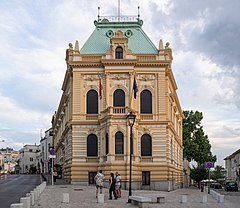Austria–Serbia relations
 | |
Austria |
Serbia |
|---|---|
Foreign relations exist between Austria and Serbia and their predecessor states. Austria has an embassy in Belgrade. Serbia has an embassy in Vienna and a general consulate in Salzburg. Austria is a European Union member and Serbia is a European Union candidate.
History
This section may need to be rewritten to comply with Wikipedia's quality standards. (January 2021) |
The history of relations between the two countries goes back to the

Foreign relations, as such, date from the proclamation of the Austrian Empire in 1804 and the formation in 1817 of the Principality of Serbia, an autonomous state within the Ottoman Empire. The Habsburg recognized the independence of Serbia and established diplomatic relations in 1874, supported by the Treaty of Berlin (1878).
Hungarian suppression of Serbian revolts during the
Following the July Crisis, Austro-Hungary launched three unsuccessful offensives to punish Serbia for allegedly supporting the assassins. In October 1915 with the help of German and Bulgarian forces, Serbia was finally conquered and divided into separate occupation zones. The northern three-quarters of Serbia was placed under a harsh Austro-Hungarian occupational regime until its liberation by allied forces in 1918.[3]
The First World War eventually destroyed the Austro-Hungarian Empire, leaving a shrunken
A number of Serb medical doctors and veterinarians got educated in Austria during the interwar period and earlier as well.[5]

Population
There are between 200,000 and 300,000 people of Serbian descent living in Austria.[6] There are also 3,000 Austrian expats in Serbia, making it home to the largest Austrian population in the Eastern European region (besides Romania).
Diplomacy
- Serbia has an embassy in Vienna and a consulate-general in Salzburg
- Austria has an embassy in Belgrade and a consulate-general in Niš
-
Austrian Embassy in Belgrade
-
Serbian embassy in Vienna
See also
- Foreign relations of Austria
- Foreign relations of Serbia
- Accession of Serbia to the European Union
- Serbs in Austria
- Austria–Yugoslavia relations
- Serbskija novini
References
- ISBN 978-1-317-03217-5.
- ISBN 978-1-134-85703-6.
- ISBN 978-1-55753-838-3.
- ISBN 978-0-253-06089-1.
- ISBN 86-7403-085-8.
- ^ 20 Minuten Online: Serben-Demo eskaliert in Wien
Further reading
- Trivanovitch, Vaso. "Serbia, Russia, and Austria during the Rule of Milan Obrenovich, 1868-78" Journal of Modern History (1931) 3#3 pp. 414-440 online
External links
- Austrian Foreign Ministry: list of bilateral treaties with Serbia (in German only)
- Austrian embassy in Belgrade (in German and Serbian only)
- Serbian Ministry of Foreign Affairs about relations with Austria
- Serbian embassy in Vienna (in German and Serbian only)
- Serbian general consulate in Salzburg (in German and Serbian only)




